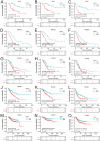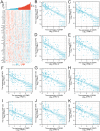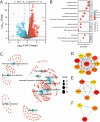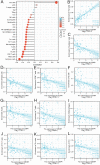Pan-Cancer Analysis Reveals CENPI as a Potential Biomarker and Therapeutic Target in Adrenocortical Carcinoma
- PMID: 37465344
- PMCID: PMC10350421
- DOI: 10.2147/JIR.S408358
Pan-Cancer Analysis Reveals CENPI as a Potential Biomarker and Therapeutic Target in Adrenocortical Carcinoma
Abstract
Background: Centromere protein I (CENPI) has been shown to affect the tumorigenesis of breast and colorectal cancers. However, its biological role and prognostic value in other kinds of cancer, especially adrenocortical carcinoma (ACC), remained to be further investigated.
Methods: Various bioinformatics tools were adopted for exploring the significance of differential expression of CENPI in several malignant tumors from databases such as Depmap portal, GTEx, and TCGA. ACC was selected for further analyzed, and information such as clinicopathological features, the prognostic outcome of diverse subgroups, differentially expressed genes (DEGs), co-expression genes, as well as levels of tumor-infiltrating immune cells (TIIC), was extracted from multiple databases. To verify the possibility of CENPI as a therapeutic target in ACC, drug sensitivity assay and si-RNA mediate knockdown of CENPI were carried out.
Results: The pan-cancer analyses showed that the CENPI mRNA expression levels differed significantly among most cancer types. Additionally, a high precision in cancer prediction and close relation with cancer survival indicated that CENPI could be a potential candidate biomarker to diagnose and predict cancer prognosis. In ACC, CENPI was closely related to multiple clinical characteristics, such as pathological stage and primary therapy outcome. High CENPI levels predicted poor overall survival (OS), progression-free interval (PFI), and disease-specific survival (DSS) of ACC patients, particularly for different clinical subgroups. Moreover, the expression of CENPI showed positive relationship to Th2 cells but negatively related to most of the TIICs. Furthermore, drug sensitivity assay showed that vorinostat inhibit CENPI expression and ACC cell growth. Additionally, si-RNA mediated knockdown of CENPI inhibited ACC cell growth and invasion and showed synergistic anti-proliferation effect with AURKB inhibitor barasertib.
Conclusion: Pan-cancer analysis demonstrated that CENPI is a potential diagnostic and prognostic biomarker in various cancers as well as an anti-ACC therapeutic target.
Keywords: CENPI; adrenocortical carcinoma; diagnosis; pan-cancer analysis; prognostic biomarker.
© 2023 Wu et al.
Conflict of interest statement
All author(s) claimed no competing interests.
Figures













Similar articles
-
Cartilage oligomeric matrix protein acts as a molecular biomarker in multiple cancer types.Clin Transl Oncol. 2023 Feb;25(2):535-554. doi: 10.1007/s12094-022-02968-8. Epub 2022 Oct 18. Clin Transl Oncol. 2023. PMID: 36255654
-
Identification of SHCBP1 as a potential biomarker involving diagnosis, prognosis, and tumor immune microenvironment across multiple cancers.Comput Struct Biotechnol J. 2022 Jun 18;20:3106-3119. doi: 10.1016/j.csbj.2022.06.039. eCollection 2022. Comput Struct Biotechnol J. 2022. PMID: 35782736 Free PMC article.
-
Immune infiltration related CENPI associates with the malignant features and drug resistance of lung adenocarcinoma.Biochim Biophys Acta Mol Basis Dis. 2024 Mar;1870(3):167017. doi: 10.1016/j.bbadis.2024.167017. Epub 2024 Jan 15. Biochim Biophys Acta Mol Basis Dis. 2024. PMID: 38232915
-
A Pan-Cancer Analysis Reveals the Prognostic and Immunotherapeutic Value of Stanniocalcin-2 (STC2).Front Genet. 2022 Jul 22;13:927046. doi: 10.3389/fgene.2022.927046. eCollection 2022. Front Genet. 2022. PMID: 35937984 Free PMC article. Review.
-
Key MicroRNA's and Their Targetome in Adrenocortical Cancer.Cancers (Basel). 2020 Aug 6;12(8):2198. doi: 10.3390/cancers12082198. Cancers (Basel). 2020. PMID: 32781574 Free PMC article. Review.
Cited by
-
Bioinformatics Combined With Biological Experiments to Identify the Pathogenetic Link of Type 2 Diabetes for Breast Cancer.Cancer Med. 2025 Apr;14(7):e70759. doi: 10.1002/cam4.70759. Cancer Med. 2025. PMID: 40202151 Free PMC article.
-
Identification of immunogenic HLA-A*02:01 epitopes associated with HCC for immunotherapy development.Hepatol Commun. 2025 Feb 26;9(3):e0659. doi: 10.1097/HC9.0000000000000659. eCollection 2025 Mar 1. Hepatol Commun. 2025. PMID: 40008881 Free PMC article.
-
The m6A reader YTHDF3 promotes TNBC progression by regulating CENPI stabilization.Front Oncol. 2025 May 8;15:1546723. doi: 10.3389/fonc.2025.1546723. eCollection 2025. Front Oncol. 2025. PMID: 40406242 Free PMC article.
-
A new predictive factor VGF based on IHC experiments, gene pathways and molecular functional groups for tumor immune microenvironment and prognosis of adrenocortical carcinoma.Front Immunol. 2025 Apr 17;16:1542780. doi: 10.3389/fimmu.2025.1542780. eCollection 2025. Front Immunol. 2025. PMID: 40313932 Free PMC article.
References
LinkOut - more resources
Full Text Sources
Miscellaneous

